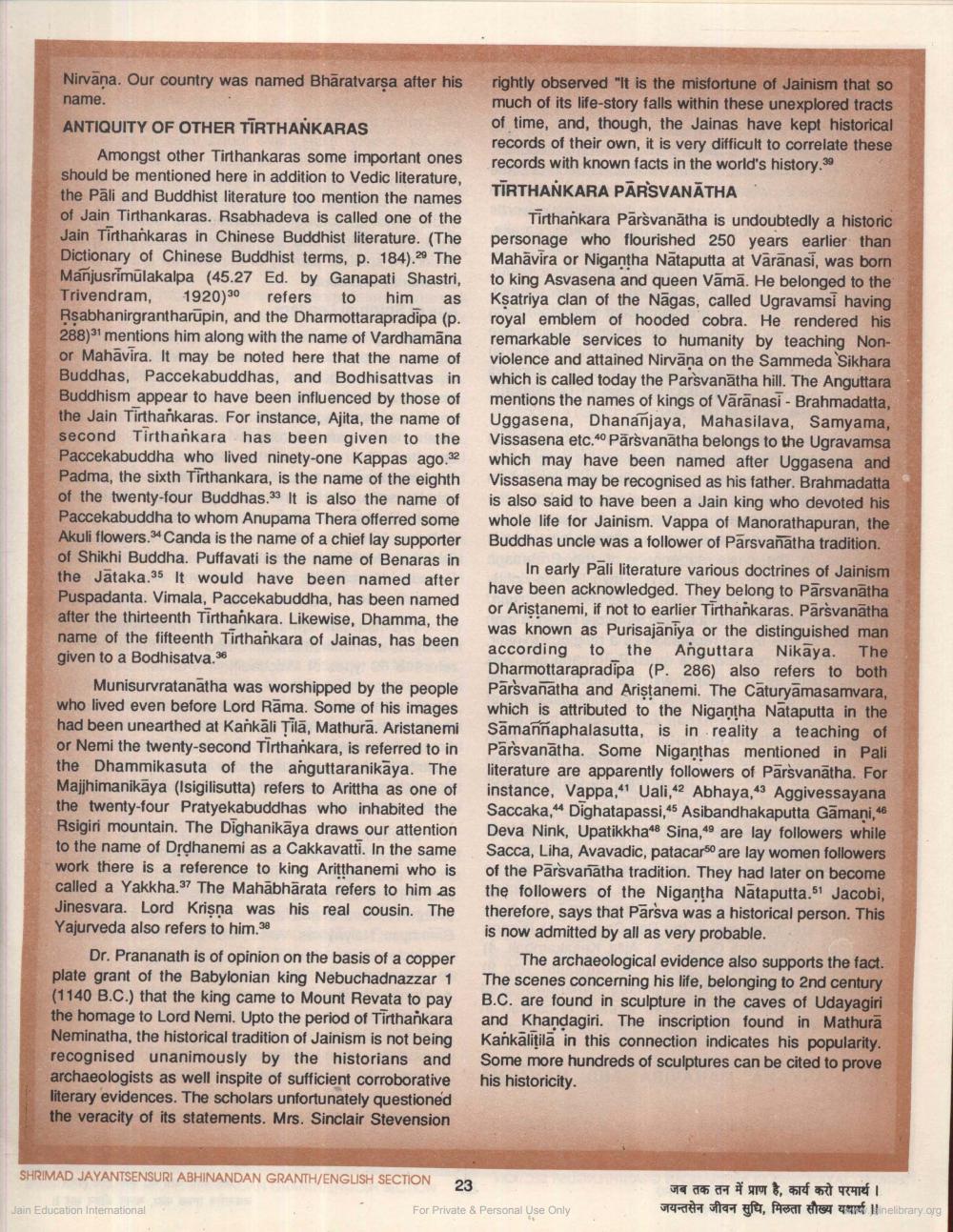________________
Nirvana. Our country was named Bhāratvarsa after his name ANTIQUITY OF OTHER TĪRTHANKARAS
Amongst other Tirthankaras some important ones should be mentioned here in addition to Vedic literature, the Pāli and Buddhist literature too mention the names of Jain Tirthankaras. Rsabhadeva is called one of the Jain Tirthankaras in Chinese Buddhist literature. (The Dictionary of Chinese Buddhist terms, p. 184).29 The Manjusrimulakalpa (45.27 Ed. by Ganapati Shastri, Trivendram, 1920)30 refers to him as Rsabhanirgrantharupin, and the Dharmottarapradipa (p. 288) mentions him along with the name of Vardhamāna or Mahāvira. It may be noted here that the name of Buddhas, Paccekabuddhas, and Bodhisattvas in Buddhism appear to have been influenced by those of the Jain Tirthankaras. For instance, Ajita, the name of second Tirthankara has been given to the Paccekabuddha who lived ninety-one Kappas ago.32 Padma, the sixth Tirthankara, is the name of the eighth of the twenty-four Buddhas, 33 It is also the name of Paccekabuddha to whom Anupama Thera offerred some Akuli flowers.34 Canda is the name of a chief lay supporter of Shikhi Buddha. Puffavati is the name of Benaras in the Jätaka.35 It would have been named after Puspadanta. Vimala, Paccekabuddha, has been named after the thirteenth Tirthankara. Likewise, Dhamma, the name of the fifteenth Tirthankara of Jainas, has been given to a Bodhisatva.36
Munisurvratanatha was worshipped by the people who lived even before Lord Rāma. Some of his images had been unearthed at Kankāli Tilā, Mathurā. Aristanemi or Nemi the twenty-second Tirthankara, is referred to in the Dhammikasuta of the anguttaranikāya. The Majjhimanikāya (Isigilisutta) refers to Arittha as one of the twenty-four Pratyekabuddhas who inhabited the Rsigiri mountain. The Dighanikāya draws our attention to the name of Drdhanemi as a Cakkavatti. In the same work there is a reference to king Aritthanemi who is called a Yakkha.37 The Mahābhārata refers to him as Jinesvara. Lord Krisna was his real cousin. The Yajurveda also refers to him.38
Dr. Prananath is of opinion on the basis of a copper plate grant of the Babylonian king Nebuchadnazzar 1 (1140 B.C.) that the king came to Mount Revata to pay the homage to Lord Nemi. Upto the period of Tirthankara Neminatha, the historical tradition of Jainism is not being recognised unanimously by the historians and archaeologists as well inspite of sufficient corroborative literary evidences. The scholars unfortunately questioned the veracity of its statements. Mrs. Sinclair Stevension
rightly observed "It is the misfortune of Jainism that so much of its life-story falls within these unexplored tracts of time, and, though, the Jainas have kept historical records of their own, it is very difficult to correlate these records with known facts in the world's history. 30 TĪRTHANKARA PĀRSVANĀTHA
Tirthankara Pārsvanātha is undoubtedly a historic personage who flourished 250 years earlier than Mahāvira or Nigantha Nātaputta at Varanasi, was born to king Asvasena and queen Vāmā. He belonged to the Ksatriya clan of the Nāgas, called Ugravamsi having royal emblem of hooded cobra. He rendered his remarkable services to humanity by teaching Nonviolence and attained Nirvāṇa on the Sammeda Sikhara which is called today the Parsvanātha hill. The Anguttara mentions the names of kings of Vārānasi - Brahmadatta, Uggasena, Dhananjaya, Mahasilava, Samyama, Vissasena etc.40 Pärsvanātha belongs to the Ugravamsa which may have been named after Uggasena and Vissasena may be recognised as his father. Brahmadatta is also said to have been a Jain king who devoted his whole life for Jainism. Vappa of Manorathapuran, the Buddhas uncle was a follower of Parsvanatha tradition.
In early Pali literature various doctrines of Jainism have been acknowledged. They belong to Pārsvanātha or Aristanemi, if not to earlier Tirthankaras. Pārsvanatha was known as Purisajaniya or the distinguished man according to the Anguttara Nikāya. The Dharmottarapradipa (P. 286) also refers to both Pārsvanatha and Ariştanemi. The Caturyāmasamvara, which is attributed to the Nigantha Nataputta in the Sämannaphalasutta, is in reality a teaching of Parsvanātha. Some Niganthas mentioned in Pali literature are apparently followers of Parsvanātha. For instance, Vappa,41 Uali,42 Abhaya, 43 Aggivessayana Saccaka, 44 Dighatapassi,45 Asibandhakaputta Gāmani, 46 Deva Nink, Upatikkha Sina, 49 are lay followers while Sacca, Liha, Avavadic, patacarso are lay women followers of the Pārsvanatha tradition. They had later on become the followers of the Nigantha Nataputta. Jacobi, therefore, says that Parsva was a historical person. This is now admitted by all as very probable.
The archaeological evidence also supports the fact. The scenes concerning his life, belonging to 2nd century B.C. are found in sculpture in the caves of Udayagiri and Khandagiri. The inscription found in Mathura Kankälitilā in this connection indicates his popularity. some more hundreds of sculptures can be cited to prove his historicity.
SHRIMAD JAYANTSENSURI ABHINANDAN GRANTH/ENGLISH SECTION
23
जब तक तन में प्राण है, कार्य करो परमार्थ । opt a afg, feat they are linelibrary org
Jain Education International
For Private & Personal Use Only




